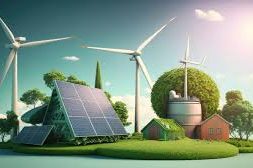
Advances in the energy industry are not surprising since it was one of the earliest to embrace digital technologies way back in the 1970s. Today, the early adoption is paying dividends.
Guest Column by Anil Chaudhry
The World Economic Forum’s Technology Tipping Points and Societal Impact report reveals dramatic predictions for 2025. These include 10% people wearing garments connected to the Internet; the first 3D-printed liver transplant; the first city housing 50,000-plus residents but without traffic lights; etc.
Clearly, digital disruptions are impacting multiple sectors, including energy. Every year, digital innovations are making energy systems more connected, efficient, accessible, reliable, smarter, safer and sustainable. Advances in the energy industry are not surprising since it was one of the earliest to embrace digital technologies way back in the 1970s. This was when power utilities deployed emerging technologies in facilitating operations and grid management.
Benefitting the Entire Chain
Today, the early adoption is paying dividends because buildings are responsible for almost one-third of global energy usage and 55% of its electricity demand. In fact, in swiftly-emerging economies such as India and China, electricity demand in buildings grew by an average of more than 8% annually during the past decade. Here is where digitalisation via smart lighting and smart grids, among others, can reduce total energy consumption by up to 10% in residential and commercial structures between this year and 2040.
Worldwide, the shift towards the new era of efficient energy is propelled by the 3Ds: digitalisation, decarbonisation and decentralisation. These three factors are determining how companies are purchasing power, deploying energy and operating in a more sustainable manner. Digitalisation is boosting the complete value chain from power generation right up to consumption, ensuring better efficiency, greater control and higher value from limited resources.
Coming to decarbonisation, it is enhancing energy efficiency and sustainability of operations. Research indicates almost 82% of cost-effective energy efficiency potential remains untapped in buildings. In the case of industry, the figure stands at more than 50%. For energy grids, experience shows the demand side delivers thrice the amount of decarbonisation compared to the supply side. Decarbonisation can be enhanced by tracking the carbon footprints of all company activities and services through a sustainability index. This can help in innovating and creating products and services having higher energy efficiency and, thereby, moving towards becoming a carbon-neutral company.
Decentralisation is driven by deep declines in the costs of distributed generation, distributed storage and other expenses on distributed energy resources, spurring flexibility in demand and greater energy efficiency. Decentralisation opportunities are increasing in solar, smart grids, micro-grids and grid automation. As renewable energy rates keep falling and more efficient storage solutions keep arising, decentralisation will accelerate.
Considering the perennial power distribution woes across the country, digitalisation offers immense opportunities for enhancing efficiencies in this segment. Traditionally, the energy equation has always been addressed through the supply side by calibrating the quantum of electricity generated and ascertaining that supply and demand are matched. But pure supply-side solutions won’t meet official obligations in curbing carbon emissions and lowering energy consumption.
In the new energy era, however, where lives are more connected, the problem can be resolved from the demand side or the energy user’s perspective. Power utilities can operate with optimal efficiency by deploying automation, software and data analytics, thereby making the energy value chain more predictable and intelligent. The Internet of Things (IoT) and Cloud capabilities are especially essential elements for power utilities wanting to monitor and manage equipment across a network of assets in the grid environment. Demand-side management is key because it is typically two to three times more costly to generate a kWh of electricity than it is to save the same.
Boosting Clean Energy
One of the biggest spinoffs of digitalisation – it is revolutionizing renewable energy. The IoT and Big Data Analytics ensure utilities can oversee their plants across large networks efficiently even while producing power and monitoring performance 24×7. The rising share of renewables in the energy mix benefits not just the environment but the economy too. A recent industry report by the International Renewable Energy Agency highlights that global GDP can increase more than 1%, reaching around $1.3 trillion, if renewables’ market share doubles by 2030.
Numerous benefits accrue to utilities from digitalising energy systems. These include maintaining grid stability; monitoring the grid and swiftly pinpointing faults; optimising and forecasting energy production; managing distributed generation; and allowing consumers more control. Besides these, digital systems permit two-way communication between producers and consumers of energy while increasing the count of ‘prosumers’ or those who are both producers as well as consumers of energy. The latter is seen in the case of solar power. Two-way communication ensures distributed energy can be sent to areas requiring it more, such as those facing supply shortages, grid stability problems or where renewables can only provide intermittent energy supplies.
Meanwhile, as energy systems get digitalised, some challenges are bound to arise – such as the new skills required by power personnel and the risks arising from data security. Nonetheless, these can be managed through training and robust security firewalls, respectively.
There is no doubt that society and the world at large will benefit tremendously from a cleaner fuel mix backed by digitalised energy systems. Moreover, new employment opportunities will be generated by deploying digital technologies even as consumers receive a wider choice of efficient energy options. The availability of 24×7 power due to digital technologies will help pull millions out of poverty due to the extra opportunities emerging through energy security.
The writer is Country President & Managing Director – Schneider Electric India. Views expressed here are the author’s own.











